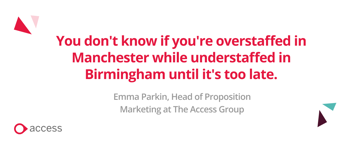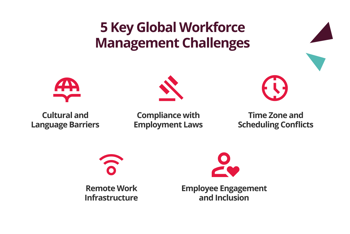
What are the 6 key global workforce management challenges?
Managing international teams requires more than simply scaling up existing HR processes. Organisations with 500+ employees often face structural, legal and cultural complexities that demand tailored approaches. Here are six of the biggest challenges:
1. Cultural and Language Barriers
Diverse teams bring rich perspectives and innovation, but they can also face challenges if cultural and language differences are not managed effectively. Miscommunication can occur around simple things like how feedback is given, working styles, or even humour in emails.
For example, a UK manager might interpret silence as agreement, while a team member from another culture may be showing respect by not contradicting openly. Without cultural intelligence, misunderstandings can erode trust and slow down projects.
To address this, organisations can look to:
- Invest in cultural awareness programmes.
- Provide multilingual documentation for policies and processes.
- Encourage managers to use inclusive communication practices such as checking for understanding and allowing space for different perspectives.
CIPD’s Creating and developing positive organisational cultures for learning and inclusion argues that inclusive cultures, where people feel they can be their true selves and differences are recognised, increase trust, understanding, and “closeness and collaboration”
2. Compliance with Employment Laws
Employment laws vary widely across countries, and for medium and large businesses this can be a minefield. Working hours, overtime, benefits, and termination rules all differ, and non-compliance risks financial penalties as well as reputational damage.
In the UK, retail employers must comply with the Working Time Regulations around rest breaks and Sunday trading rules, while manufacturers may face sector-specific health and safety obligations. Replicating this across multiple jurisdictions without central oversight quickly becomes unmanageable.
- The UK government has tightened enforcement on holiday pay and worker classification.
- The Irish government’s Organisation of Working Time Act places limits on weekly working hours and requires employers to maintain detailed records.
Compliance represents a significant challenge for both retailers and manufacturers, however, our specially tailored HR software for retail and HR software for manufacturing can deal with compliance issues automatically.
3. Time Zone and Scheduling Conflicts
When teams stretch across continents, coordinating meetings and workflows can be difficult. This isn’t just about meetings as it can also impact productivity if decisions stall because key people are offline. As Emma Parkin, Head of Propositions at The Access Group, notes:
“You don’t know if you’re overstaffed in Manchester while understaffed in Birmingham until it’s too late.” (Strategic Workforce Management – Right People, Right Place, Right Time).
Some practical steps your large organisation can take to help with this issue include:
- Use shared calendars with automatic time-zone conversions.
- Build in asynchronous communication
- Rotate meeting times so the burden doesn’t always fall on the same region.
4. Remote Work Infrastructure
Remote and hybrid working is now an expectation, but without strong infrastructure it can create gaps. HR teams must ensure all employees, regardless of location, have access to the same tools, secure systems and communication channels. Some challenges remote employees face include:
- Cybersecurity risks from dispersed endpoints.
- Inconsistent access to collaboration tools.
- Tracking productivity without creating a culture of surveillance.
Learn more about the most pressing challenges facing remote teams and strategies to overcome them in our blog, ‘The challenges of managing a remote workforce - and how to overcome them’.
Blenheim & Pye, with teams spread across multiple sites, implemented a bespoke employee benefits platform to strengthen engagement and unify remote staff. By providing a consistent digital experience, they reduced friction and improved participation in company initiatives. Read their full Success Story for more details.
5. Employee Engagement and Inclusion
Keeping employees engaged across different time zones, locations and cultures is one of the hardest tasks for HR leaders. Without proactive effort, global workforces risk feeling fragmented, leading to lower morale and retention issues.
Strategies to foster engagement include:
- Virtual team-building sessions.
- Recognition programmes that celebrate contributions across borders.
- Diversity, Equity and Inclusion (DEI) initiatives tailored to each region
As Emma Parkin, Head of Propositions at The Access Group, puts it in Beyond the Payslip – From Scattered Benefits to Strategic Retention:
“Happy employees are more productive, more engaged, and become your best advocates for attracting new talent.”
To connect with a dispersed workforce, engagement needs to consider the type of industry and context. For example, manufacturing and retail sectors face unique challenges, which are explored further in our blogs on employee engagement in manufacturing and employee engagement in retail, with actionable strategies to implement to improve engagement.
6. Global Mobility Strategy
For large organisations, global mobility factors like managing relocations, secondments and cross-border assignments can present a compliance risk. Without structured policies, costs can escalate, and employees can struggle with logistical challenges.
Expert Insight
Understanding and complying with employment laws across different regions is one of the most complex aspects of managing a global workforce.
Emma Parkin, Head of Propositions at The Access Group, explore the legal rights of shift workers and how strategic workforce management can help organisations stay compliant while supporting employee wellbeing.

What are the 7 strategies you can employ to overcome global workforce challenges?
While challenges are significant, they can be turned into competitive advantages with the right strategies.
1. Invest in Cross-Cultural Training
Cultural sensitivity training equips managers and teams to navigate differences effectively. Gartner research shows that building cultural connectedness, alignment, and inclusion can boost employee performance and retention. They report that cultural connectedness can increase employee performance by up to ≈37% and retention by up to ≈36%.
2. Use Global HR Technology
Automation and integrated HR systems are essential for managing processes across borders. From payroll to performance reviews, global HR technology creates consistency while allowing local flexibility.
3. Build a Flexible Work Culture
Work flexibility is about empowering employees to work with responsibility and accountability, rather than just a directive to be able to work from anywhere. This could include flexible hours, results-based performance reviews, or region-specific leave policies. CIPD reports that 60% of employees say they have some form of flexible working arrangement in their current role and that employees with flexible working arrangements reported higher job satisfaction, better work–life balance, and more control over their work.
4. Standardise While Localising HR Policies
Enterprises often face a delicate balancing act when shaping global policies. On one hand, enforcing a uniform approach across all regions can overlook important local nuances. On the other, allowing each region to operate independently may lead to inconsistency.
A more effective path is to adopt a strategy that blends global consistency with local relevance:
- Establish core global policies that reflect universal values, such as a Code of Conduct or diversity and inclusion principles.
- Enable local adaptations to account for regional employment laws, cultural norms, and public holidays.
This balanced approach helps reduce compliance risks while fostering cohesion across the organisation.
5. Enable Middle Managers Across Borders
Middle managers play a key role in managing across borders as they translate strategy into daily actions. However, they can be under-supported which can hinder the ability to manage distributed teams. Supporting middle managers can include:
- Leadership coaching with a global focus.
- Access to digital dashboards showing team performance across regions.
- Peer networks where managers can share challenges and best practice.
6. Align Workforce Planning with Business Strategy
Strategic workforce planning (SWP) aligns future talent availability with long-term goals. For global businesses, this means forecasting not only headcount but also skills across geographies.
For example, if a professional services firm plans expansion into Ireland, SWP can identify skill shortages in Dublin and model recruitment vs reskilling costs.
For more information on strategic workforce planning and how it can help your organisation grow, read our article on ‘How Strategic Workforce Planning Powers Enterprise Growth’.
7. Establish Clear Communication Protocols
A breakdown in communication can be a leading cause of inefficiency in global teams. Investing in tools that standardise communication protocols can help ensure clarity. Some practical steps you can take include:
- Mandating centralised communication tools such as Teams or Slack.
- Producing multilingual documentation for key policies.
- Using agreed channels for different message types (e.g., Slack for daily updates, email for formal announcements).

How to future-proof your global workforce strategy
Managing a global workforce is complex, but with the right mindset and tools it becomes an opportunity to gain a competitive edge. To recap:
- Cultural barriers require cross-cultural intelligence and inclusive communication.
- Compliance demands proactive monitoring and integrated HR platforms.
- Time zones can be overcome with asynchronous practices and scheduling discipline.
- Remote infrastructure must be secure, consistent and employee centric.
- Engagement is the glue that keeps dispersed teams aligned.
- Mobility strategies ensure international assignments add value without unnecessary cost.
Whilst global vendors promise worldwide coverage, UK businesses often find local expertise more valuable. Our review of the best HCM systems in the UK compares UK-focused providers against global platforms, examining local compliance knowledge and support.
Ready to simplify global workforce management?
- Book a demo of Access PeopleXD Evo to see how our platform can help you streamline HR processes, boost engagement, and stay compliant across borders.
- Short on time? Watch our 4-minute demo to discover how PeopleXD empowers HR teams to manage global workforces with ease, or download our Brochure.
- Learn more about Access PeopleXD Evo’s capabilities, from payroll and talent management to employee engagement and analytics.

 AU & NZ
AU & NZ
 SG
SG
 MY
MY
 US
US
 IE
IE
